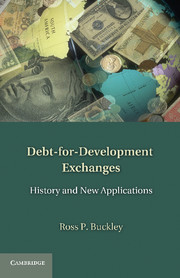Book contents
- Frontmatter
- Contents
- Acknowledgments
- List of Contributors
- Introduction: A Productive Partnership between Civil Society and the Academy
- Part I Types of Exchanges and Their Development over Time
- Part II Exchanges by Donor Countries
- 4 United States Debt Exchanges
- 5 Italian Exchanges
- 6 German Exchanges
- 7 French Exchanges
- 8 Other Donor Nations' Exchanges
- 9 Debt-for-Development Exchanges in Australia: Past, Present and Future
- Part III Critiques of Exchanges
- Part IV Innovative Applications of Exchanges
- Conclusion
- Index
- References
4 - United States Debt Exchanges
Published online by Cambridge University Press: 01 June 2011
- Frontmatter
- Contents
- Acknowledgments
- List of Contributors
- Introduction: A Productive Partnership between Civil Society and the Academy
- Part I Types of Exchanges and Their Development over Time
- Part II Exchanges by Donor Countries
- 4 United States Debt Exchanges
- 5 Italian Exchanges
- 6 German Exchanges
- 7 French Exchanges
- 8 Other Donor Nations' Exchanges
- 9 Debt-for-Development Exchanges in Australia: Past, Present and Future
- Part III Critiques of Exchanges
- Part IV Innovative Applications of Exchanges
- Conclusion
- Index
- References
Summary
The development of debt-for-nature exchanges and broader forms of debt exchanges has been encouraged partly by various US congressional initiatives, which have highlighted the relationship between debt and the environmental and developmental problems of developing countries. The motivation for these enactments has, perhaps not unexpectedly, arisen largely from self-interest. The United States has significant bilateral trade, investment and strategic relationships with a number of countries struggling under severe debt burdens, particularly in Latin America – the region that ever since the Monroe Doctrine the United States has considered its backyard and over which it claims an entitlement to exercise a special oversight. Efforts to address their development needs, and the sustainability of their economies, were designed to promote strategic interests in the region. Stronger Latin American economies expand the potential market for US goods, services and investment capital. Consequently, the United States has encouraged its lenders to participate in debt-exchange transactions in the region by way of the legislative initiatives. Debt-for-nature exchanges have since the 1980s been conducted by the United States by way of three legislative initiatives.
1989 GLOBAL ENVIRONMENTAL PROTECTION ASSISTANCE ACT (US)
In April 1988 the United States Agency for International Development (USAID) issued debt-for-development guidelines that proposed funding of nongovernmental organisation (NGO) intermediaries for approved debt exchanges. The NGOs would then be responsible for negotiating with qualifying developing countries and for managing the use of the resources acquired through the exchange.
- Type
- Chapter
- Information
- Debt-for-Development ExchangesHistory and New Applications, pp. 51 - 66Publisher: Cambridge University PressPrint publication year: 2011



